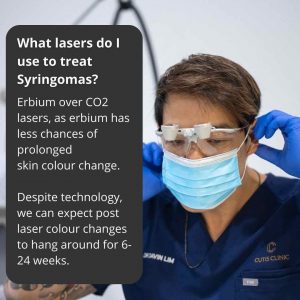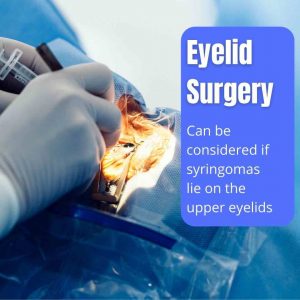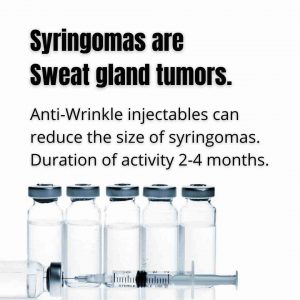At A Glance Syringomas
- Best Results1-2 sessions
- Treatment Recovery7+ days
- Procedure Time30 minutes
- Skin SpecialistDermatologist
- Duration of ResultsVariable
- AnaestheticNumbing + local blocks + sedation
- Back to Work5-7 days
- Cost$$ (Medicare Subsidy Applies)
Syringomas
Syringomas are tiny bumps & lumps under the skin. They frequently involve the upper & lower eyelids. This is classed as a benign, non-cancerous tumor of the eccrine or sweat glands. These lesions are best treated with erbium or CO2 lasers. As this is a genetic condition, recurrence is often seen.
FactsFacts On Syringomas
- These are common benign tumours of skin
- Syringomas are more frequent in Asian – Ethnic patients
- Syringomas are skin-coloured bumps around the eyelids
- Extensive eruptive syringomas can affect the chest, face & limbs
- Laser ablation gives the best results
- Small isolated syringoma can be treated with fine wire hyfrecation
- A partial Medicare rebate applies to the removal of benign facial tumours
Who gets Syringomas?
These tumours are most commonly found in young adults. They are more frequently seen in ethnicities including Chinese, however, they also occur in other populations. Syringomas are usually present in mid-teens to early adulthood. They are asymptomatic however may enlarge in summer or the hotter months due to increased production of sweat.
Where do they occur?
Most commonly syringomas occur on the lower eyelids followed by upper eyelids. Eruptive lesions can be seen around the mouth, chest & limbs. Syringoma can resemble viral warts & are frequently mistaken for cholesterol deposits known as xanthelasmas. They may look like milia, cysts or whiteheads.

What do they look like?
Syringomas are tiny 1-3 mm spots & dots that lie underneath the skin. They are most frequently found around the lower & upper eyelids. Rare cases are ‘eruptive and occur on the chest, abdomen & even on the legs. In some cases, they seem to get larger during the hotter days of summer (due to increased sweat activity). Unlike xanthelasma, syringomas are more numerous & often skin colored.
How are they different from milia?
These lesions frequently occur around the eyes & clinical differentiation can be tricky. Milia are generally rounder (like a 1-2 mm ball), whilst syringomas are flatter (plaque-like), and often skin coloured compared to milia, which are whiter. If in doubt a tiny 1-2 mm skin biopsy can differentiate between these conditions.
Other conditions such as trichodiscomas, fibrofolliculomas, angiofibromas, xanthelasmas & plane warts should be considered in the diagnosis, these will have specific histological features on biopsy.

View our Treatment Gallery
How to treat?
Syringomas are best treated with lasers including the erbium & CO2 ablative laser. I also treat isolated lesions with fine wire diathermy, TCA & surgical excision. Laser resurfacing probably gives the best outcome, whilst surgical excision gives the highest cure rate.

Will laser get rid of all syringomas?
No. When I apply ablative lasers it is to remove as much as we possibly can whilst minimising the risks of scarring & pigmentation. During the laser procedure I will have an understanding of the depth of these lesions. In some cases, I remove 95% of syringomas in one sitting, in others it may only be 40%. The deeper I chase these lesions, the higher the chances of scarring.

Syringomas are sweat duct benign tumors
.
🔬Skin science: these tumors are common. More in Asian cf. other races. They can be very tricky to treat, especially in darker skin types. This patient has skin type 4, #melasma also complicates things. Treatment options-
.
👉Erbium ablative (I used erbium for this case)
.
👉CO2 ablative
.
👉Snip excision
.
👉TCA 30-50%
.
👉Diathermy- hyfrecation
.
👉Excision
.
👉RF ablation (needle)
.
👉Botox reduces sweating, hence can reduce recurrence. Syringomas are genetic, recurrence is the rule
.
😎Dr Davin Lim
Dermatologist
Brisbane🇦🇺
@drdavinlim
.
#syringomas #lasersurgery #laserdermatology #co2laser #co2laserresurfacing #mydayjob e #dermatologistbrisbane #drdavinlim #skinscience #3rounds #erbiumlaser #laserresurfacing #eyerejuvenation #laserdermatologist #brisbane4skin #skinresurfacing
Not all bumps are milia. These are plane warts. Yes, due to the lockdown in Brisbane, this dermatologist is back treating WARTS😂😂
.
🔬Skin Science: There are many causes of facial bumps including milia, adnexal tumors such as syringomas, trichodiscomas, fibrofolliculomas, trichilemmomas, apocrine hidrocystomas and more. Plane warts are relatively common. They are associated with Human Papilloma Virus, usually 3 & 10. Warts can be associated with immune deficiencies & rare genetic causes like epidermodysplasia verruciformis
.
🔫👉Treatment options: Discuss with your medical dermatologist. Most warts self resolve. Simple focal keratolytics including high strength salicylic acid, Upton paste, retinoids (topical, oral in severe cases), immune modulators, imiquimod, cryotherapy, electrodessication, PDT, intralesional bleomycin etc...can clear warts
.
🤔This patient: Has skin type 4. I treated her with a focal ablative erbium laser. CO2 is another option. For plantar warts, vascular lasers can target the vessels
.
👍🏻Post care: usual emollients. Retinoids topically as adjunctive therapy.
.
I hate lockdown….😩
.
😎Davin Lim
Dermatologist🇦🇺
.
#donthasttagwartsoryouwillendupseeingthem
#dermatoloigst #drdavinlim #davinlim #brisbanedermatologist #skindoctor
Not all dots & spots are milia - milium.Eccrine hidrocystomas are not infrequent, namely isolated spots around the eyelid. Eruptive cases like this are uncommon. The usual ddx of #syringomas, trichodiscomas, fibrofolliculomas & other adnexal tumors should be considered. This patient works in a hot environment (cook), lesions worsen with heat & during the summer. This points to an eccrine origin - narrows to syringomas & eccrine hidrocystoma. The blue colour in many of these lesions are suggestive of the latter
.
.
🔬Skin Science: Much debate in the literature regarding the true origin of these lesions- some say eccrine, others say apocrine. Mainstream favours the former. This is a cystic lesion with a thin layer of epithelial cells lying in the superficial dermis. Heat increases sweating, resulting in eruptions over the summer months
.
.
👉🔫Treatment: I’m gonna use a 1mm spot on the erbium laser (actually I have given this job to Alison). Spot ablate to ‘destroy’ the cyst wall. Will take 3-4 days to recover. The rate of PIH with the erbium is vvvv low ( two taps and the job is done). 2 weeks post laser, we will deliver intradermal #Botox via #Aquagold. Btx will decrease eccrine activity, especially over summer. Much like syringomas, these lesions will recur. The aim is to treat & to give as long a remission time as possible
.
.
😎Dr Davin Lim
@drdavinlim
Brisbane🇦🇺
#laserdermatologist #dermatology #milia #syringomas #miliatreatment #skinscience #dermalscience
Syringomas are common benign tumors of the skin
.
.
🔬What causes syringomas? The name “syringoma” is derived from syrinx, the Greek word for tube or pipe. Syringomas are benign tumours of the sweat ducts (eccrine glands). These tumours lie in the mid to deep (dermal) layers of the skin. The eyelid skin is most frequently affected, this case shows syringomas affecting the upper lip. Eruptive #syringomas can affect the body
.
👉Diagnosis: Most cases are diagnosed by their appearance. A biopsy may be needed to exclude other similar kinds of tumours such as trichoepitheliomas, trichodiscomas, fibrofolliculomas as well as milia and basal cell cancers. Biopsies of syringomas show comma-shaped sweat ducts in the dermal (deep) layers of the skin.
.
🔫Treatments: Fully ablative or fractional ablative devices including CO2 and erbium laser are most commonly used. #Dermatologists may combine fully ablative with fractional laser treatment in the same session allowing treatment to the deeper component of the syringoma; as in this case. Diathermy, excision & Botox (modulates eccrine gland) are other treatment options. Recurrence following treatments are not uncommon
.
👇🏻📚📖More on syringomas
https://www.dermcoll.edu.au/atoz/syringoma/
.
😎Dr Davin Lim, Dermatologist Brisbane🇦🇺
@drdavinlim
@cliniccutis
#laserdermatologist #dermatology #skindoctor #lasersurgery #fractionallaser #laserresurfacing
How long will it take to heal after laser?
6-9 days. This is when skin heals so that make up can be worn. This is very different from skin colour changes after the procedure. In Asian patients you will get skin colour changes lasting 2-12 weeks, depending on the depth of treatment. Redness is not uncommon. I will give you an indication of healing times during the consultation.
Is treatment painful?
No. I prefer to laser these lesions under mild sedation. Additionally blocks & numbing cream makes this a tolerable procedure. It takes approximately 30 minutes to complete laser surgery.

Can syringomas recur?
Yes, recurrence is the rule as the cause is genetically coded in the DNA of your skin. All treatments can reduce the look of syringomas, however the majority recur within a decade of treatment.
The use of intradermal BOTOX can reduce eccrine gland activity *sweat gland & in some cases provide longer remission.

How much is treatment?
Medicare partially covers this treatment. I can give you a better idea during the time of the consultation.
All syringoma treatments are done by Davin Lim. Milia on the other hand are managed by my nurses & therapists as the latter do not require laser surgery.

Davin’s viewpoint on treating syringomas
These are the most common benign (non-cancerous) tumours of skin I treat. Syringomas are very common in Asian patients. The biggest mistake I see is over correction of these skin lesions. Ethnic patients are prone to developing skin colour changes, but most importantly they have a brisk melanocytic & fibroblastic response. The latter can lay down abnormal collagen leading to scars. My biggest hint is to be conservative in treatments. I see way too many iatrogenic scarring due to lasers (and plasma). Better off to have 2-3 sessions compared to one with higher risks of scars.
In ethnic skin patients, post inflammatory pigmentation is generally the rule. It can take 3 to 4 months to resolve. Pico lasers can quicken resolution.

